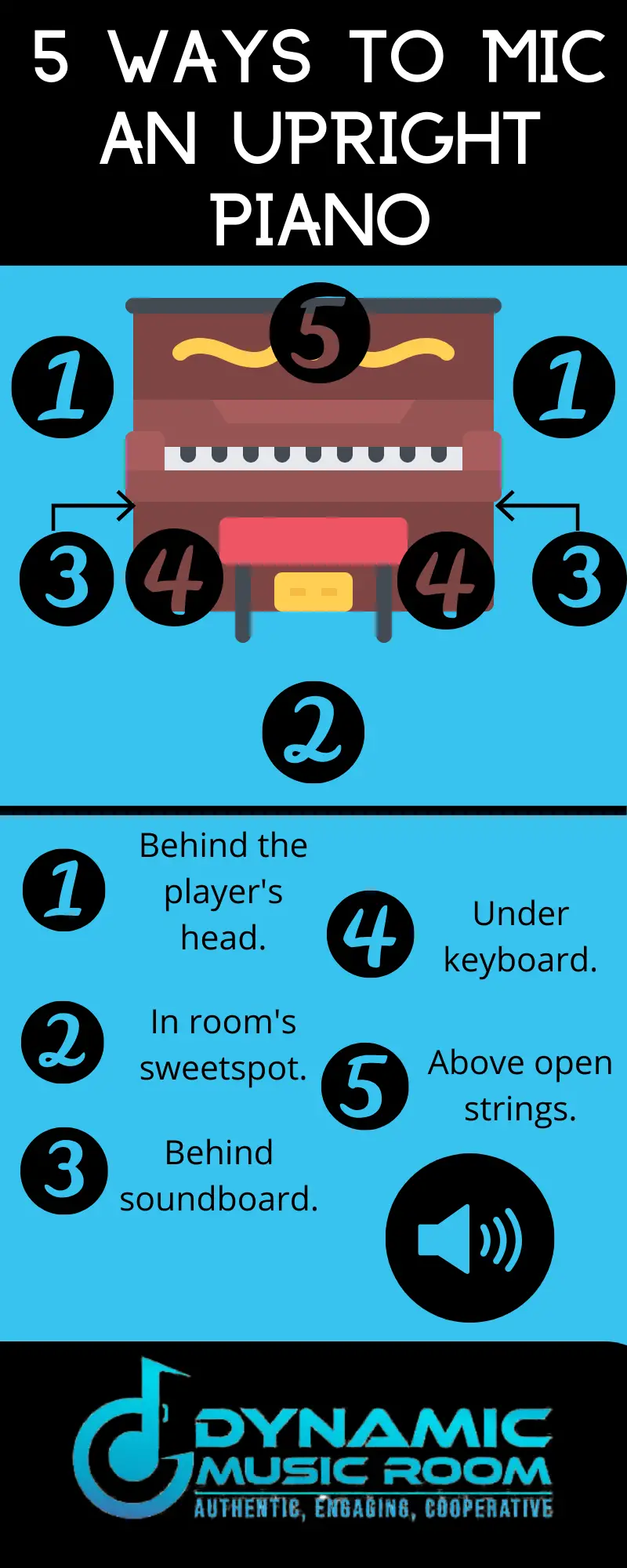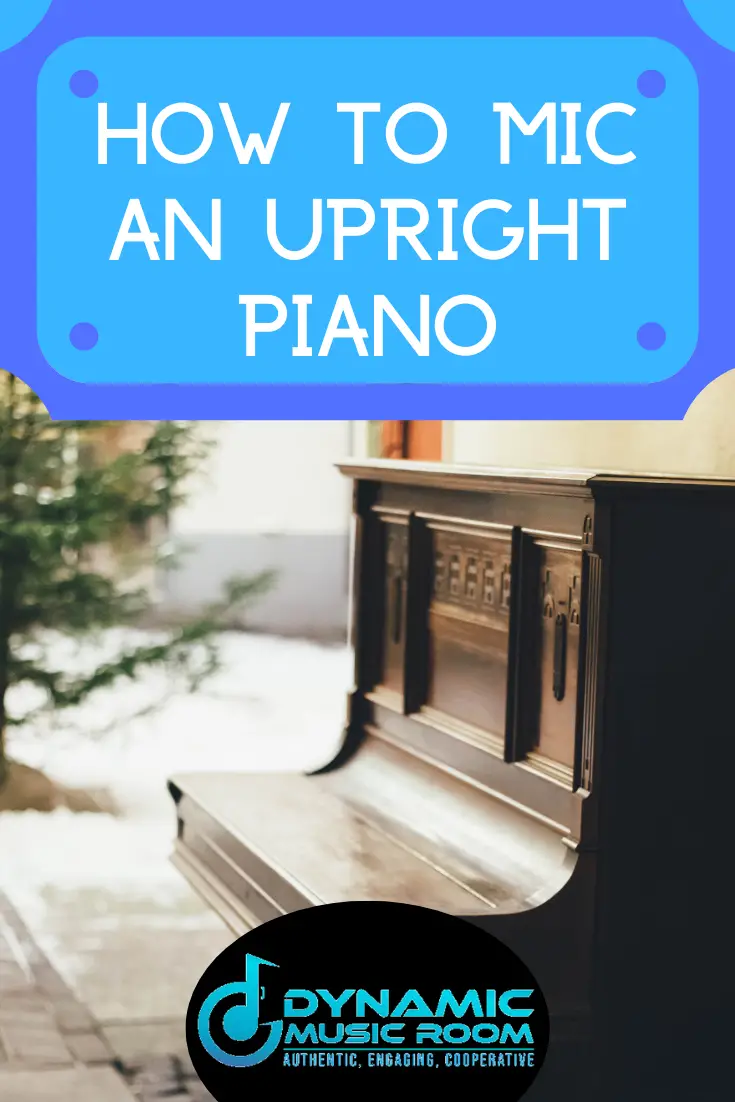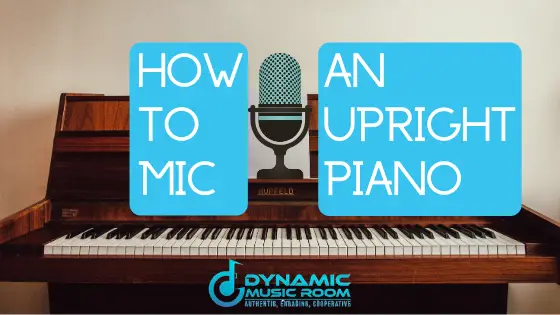Are you looking to record your upright piano playing?
Do you struggle to get the right sound from your upright piano?
Most people assume there’s one best way to mic an upright piano or any other instrument.
This isn’t true at all. In fact, knowing how to mic an upright piano is both simple and complicated.
Micing an upright piano largely depends on what style of music you’re playing and what microphones you have available. This being said, there are some general rules anyone can follow to help them record their piano playing just the way they want. (Check out how to make a piano quieter.)
Check out the rest of the article for more details.
Table of Contents
Get The Right Gear
It’s no use recording an upright piano with a microphone if you’re using low quality gear.
But, on the other hand, microphones can get expensive.
Here are my favorite mics for recording an upright piano, their general price ranges, and a couple of words about what makes each of them a good choice.
Note: Each link goes to the product on Amazon. Because prices change, you’ll need to click over to get the exact current pricing (and see if it’s on sale).
Neumann SKM 184 MT Stereo Matched Microphone Pair – This microphone pair comes with headphones and an XLR cord.
This is the best all-around to use for recording. This comes at a higher price, naturally, but the quality and the cardioid nature of these mics are hard to beat.
Blue Yeti USB Microphone – This USB mic is reasonable in price for most people. It’s also versatile with four polar patterns to capture sound in different ways.
For those who want to experiment with capturing sound without breaking the bank, check this one out.
It’s also a USB mic which means it connects quickly and easily to computers for recording, though the sound isn’t as quality as an XLR connection.
Earthworks QTC30 – This is an omnidirectional microphone which means it captures sound from every direction. This may not be perfect for every recording situation, but it will record the piano as it sounds in the room.
For a more natural sound, this is perfect. This Earthworks microphone is a little more pricey, but it’s quality is top-notch.
Audio-Technica AT875R Shotgun Condenser Microphone – This shotgun microphone is more affordable and makes an interesting piece in someone’s recording setup.
Shotgun microphones pick up sound from a direct cone in front of it and nowhere else.
You may be familiar with this microphone as the one picking up a lecturer on stage (but no one else in the room). It’s also used to pick the sound of football players crashing together on the field (without needing to be in the thick of it).

How To Mic An Upright Piano: 5 Different Ways With Suggestions
There’s no right way to mic an upright piano, but there are some ways you should check out with different ideas to give you a place to start.
#1 Behind Your Head
The first one I recommend attempting is to use two stereo microphones set up behind the piano player’s head.
Either use the Neumann ones for a killer sound or get two Blue Yetis and a sound program to record their sound in stereo.
It’s important to use cardioid or one of its variations in this setting.
The sound recorded from the microphones will pick up the natural sound of the piano in front of the mics and some room, but not so much it’s distracting.
The stereo setup will make the listener feel as if they’re behind the piano as well as the player goes up and down the keyboard.
This setup works best when the piano is in an open room. This reduces the echoes and bounces from the walls which can muddy and mess up the sound.
A setup up and behind the player’s head is an awesome all-around recording setup for any style, but it seems to be a favorite of jazz playing.
In jazz playing, the sound engineer would usually like to get more of the hammer sound, power, and definitely the highs and lows as they pan right and left.
#2 Get The Room
The other option we recommend starting with is the easiest, but it also allows for the most play in the setup.
With this option, you’re leaning into the room’s sound and just trying to capture the best sound possible.
The method for this setup depends largely on your room and your preferences.
The first thing you need to do is find the room’s sweet spot. The sweet spot is noticeable in the room because it’s where the sound seems to gather cleanly and be amplified.
There is some flexibility in the sweet spot depending on your preference as well.
Have someone play the piano while you turn on your microphone with good, noise-canceling headphones on.
Walk around the room listening to the sound while someone else plays the piano. As you listen and wander, you’ll notice the spots where the sound is the best.
Mark these spots and set up microphones there.
An omnidirectional microphone works well here for getting the whole room. You may also wish to listen to a shotgun microphone aimed at the piano directly.
Or a combination of the two may sound good to you as well.
Hint: Play around with the lid open and closed, the piano against a wall or angled away, and other things
If you’re singing while you play, aim the shotgun microphone more towards your voice and use the other mic to catch the sound of the room.
This is another good all around setup for catching a big and real sound.

#3 Intimate Behind The Soundboard
Not every song will sound and play style will sound great when capturing all the sounds of the room. Sometimes you want the sound to feel like the listener is resting their arm on the edge of your piano as you play to them one on one.
If you want an intimate sound and you want to capture the natural mellow resonance of the piano, put two microphones spaced out behind the soundboard (back of the piano).
Make sure the microphones are at least 6 inches (15.24 cm) away from the soundboard.
What you’ll end up with a full and rich sound, though the highest pitches won’t sound as strong or resonant.
The hammer sounds won’t be picked up as much, but the natural sustain from the wood of the piano will be picked up giving a clear and ringing sound.
This method works great for any quieter and slower song, especially again in the jazz, classical, and singer-songwriter style of playing.
Use this in combination with a shotgun mic aimed at a singer’s mouth for a beautiful sound.
#4 Artificially Amplify Underneath
This method works great for making the piano sound larger in a smaller room.
What you do is remove or open the panel beneath the keyboard, exposing the bottom parts of the strings.
Aim two microphones on either end of the piano and underneath the keyboard about 45° in towards the strings.
Use at least a cardioid (though hypercardioid pattern would be better) to eliminate the sound of the pedals somewhat.
Because the mics are so close to the strings it will pick up all the extra harmonic resonance in the piano and make it sound stronger.
Being so close will eliminate the echoes a small room always brings and give the piano the feel of being in a much larger space.
As a bonus, this setup is one of the only permanent ones easy to set up. Just attach the mics to the side or footer parts of the piano and run the cords down and around the piano.
Use this setup for any style or playing in a small room or for creating an easy permanent set up.
#5 Raw And Powerful
If you want to record a powerful sound, such as with rock and roll, blues, and complicated classical pieces in later musical periods.
To do this style of recording, you need to take the lid off the top of the piano. Point the microphones directly at the hammers and strings here for a full and powerful sound.
There is some wiggle room with this as well.
Place the microphones right up to the strings and hammers to get a complete stereo sound and pick up the percussive striking of the hammers.
Cardioid microphones and shotgun microphones work well here.
To get a little more mellow of a sound equal across the high and low move the microphones back until you get it right where you want it.
Commonly Asked Questions
How do you record an upright piano with one mic? – With only one mic, it’s still possible to get a solid recording sound as we touched on above.
Use a high-quality microphone on a cardioid polar pattern out in front of the instrument. Move it closer to the piano itself for a more “pure” sound and move it farther away to capture more of the room’s acoustics.
Should an upright piano be up against a wall? – Yes, the best place for an upright piano is up against an interior wall away from heaters, vents, and other things of such nature.
The wall bounces the sound back, and it also protects the sensitive part of the piano from accidental bumping or damage.
How do you record a piano at home? – Any of the techniques talked about above work well in a studio and a home setting.
For a home recording, you may wish to place the mic a little closer to the piano and select a polar pattern focusing on the sound from the front of the microphone.
This will help eliminate the echoing and other sounds your room’s may have. Consider draping some blankets on the walls to absorb some extra sound and echoes it makes.
Is it OK to put a piano in front of a window? – No, this isn’t advisable at all.
The air temperature and humidity near a window tends to fluctuate depending on time of day, weather, general climate changes throughout the year.
This fluctuation is hard on the piano and one of the reasons pianos go out of tune or worse, break.
Learn about how long it takes to tune a piano.
Final Thoughts
Now you know a little more about how to mic an upright piano.
Any of these ways may be perfect for your needs; now it’s up to you to decide which one is the right fit.
You may find it beneficial to try out a few different options and see all the choices.
Want to improve your piano skills online with a selection of over 1,500 piano songs? Check out Flowkey (click to check out the program for free).

